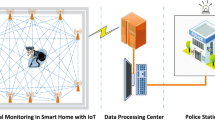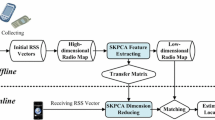Abstract
Device-free passive wireless indoor localization has attracted great interest due to the widespread deployment of Wi-Fi devices and the rapid growth in demand for location-based services. In this paper, we propose a novel device-free passive wireless localization system with a weighted transferable discriminative dimensionality reduction method (termed TLLOC). It utilizes the channel state information (CSI) extracted from a single link to estimate the location of the target, neither requiring the target to wear any electronic equipment nor deploying a large number of APs and Monitor Devices. To cope with the problem of reduced localization accuracy caused by the unpredictable nature of CSI over time that ignored by most previous CSI-based localization works, a novel weighted transferable discriminative dimensionality reduction (termed WTR) method combining transfer learning and dimensionality reduction is proposed. The WTR method constructs a low-dimensional latent space, which can simultaneously improve the discrimination of training samples and narrow the distribution divergence between the training samples and the test samples, further enhancing the performance of our system. Experimental results are presented to confirm that TLLOC can effectively improve localization accuracy while saving a great amount of the calibration cost, compared with the other existing methods in a representative indoor environment.







Similar content being viewed by others
References
Zhou, Z., Wu, C., Yang, Z., & Liu, Y. (2015). Sensorless sensing with WiFi. Tsinghua Science and Technology,20(1), 1–6.
Savazzi, S., Sigg, S., Nicoli, M., Rampa, V., Kianoush, S., & Spagnolini, U. (2016). Device-Free Radio Vision for Assisted Living: Leveraging wireless channel quality information for human sensing. IEEE Signal Processing Magazine,33(2), 45–58.
Mazuelas, S., Bahillo, A., Lorenzo, R. M., Fernandez, P., Lago, F. A., Garcia, E., et al. (2009). Robust indoor positioning provided by real-time RSSI values in unmodified WLAN networks. IEEE J-STSP,3(5), 821–831.
Ciurana, M., Barceló, F., & Cugno, S. (2006) Indoor tracking in WLAN location with TOA measurements. In Proceedings of the 4th ACM international workshop on mobility management and wireless access (pp. 121–125). ACM.
Yamasaki, R., Ogino, A., Tamaki, T., Uta, T., Matsuzawa, N., & Kato, T. (2008). TDOA location system for IEEE 802.11b WLAN. In IEEE wireless communications and networking conference (pp. 2338–2343). IEEE.
Wong, C., Klukas, R., & Messier, G.G. (2008). Using WLAN infrastructure for angle-of-arrival indoor user location. In IEEE 68th vehicular technology conference (pp. 1–5). IEEE.
Zhang, D., & Ni, L. M. (2009). Dynamic clustering for tracking multiple transceiver-free objects. In IEEE international conference on pervasive computing and communications (pp. 1–8). IEEE.
Xu, Y., Zhou, M., Meng, W., & Ma, L. (2010). Optimal KNN positioning algorithm via theoretical accuracy criterion in WLAN indoor environment. In IEEE global telecommunications conference GLOBECOM 2010 (pp. 1–5). IEEE.
Zhou, M., Xu, Y., & Tang, L. (2010). Multilayer ANN indoor location system with area division in WLAN environment. Journal of Systems Engineering and Electronics,21(5), 914–926.
Xu, C., Firner, B., Moore, R. S., Zhang, Y., Trappe, W., Howard R., & An, R. N. (2013). SCPL: Indoor device-free multi-subject counting and localization using radio signal strength. In ACM/IEEE international conference on information processing in sensor networks (IPSN) (pp. 79–90). IEEE.
Seifeldin, M., Saeed, A., Kosba, A. E., El-Keyi, A., & Youssef, M. (2013). Nuzzer: A large-scale device-free passive localization system for wireless environments. IEEE Transactions on Mobile Computing,12(7), 1321–1334.
Kaltiokallio, O., Bocca, M., & Patwari, N. (2014). A fade level-based spatial model for radio tomographic imaging. IEEE Transactions on Mobile Computing,13(6), 1159–1172.
Halperin, D., Hu, W., Sheth, A., & Wetherall, D. (2011). Tool release: Gathering 802.11 n traces with channel state information. ACM SIGCOMM Computer Communication,41(1), 53.
Wang, J., Xiong, J., Jiang, H., Jamieson, K., Chen, X., Fang, D., et al. (2018). Low human-effort, device-free localization with fine-grained subcarrier information. IEEE Transactions on Mobile Computing, 17(11), 2550–2563.
Li, X., Li, S., Zhang, D., Xiong, J., Wang, Y., Mei, H. (2016). Dynamic-MUSIC: Accurate device-free indoor localization. In Proceedings of the 2016 ACM international joint conference on pervasive and ubiquitous computing (pp. 196–207). ACM.
Qian, K., Wu, C., Yang, Z., Yang, C., & Liu, Y. (2016). Decimeter level passive tracking with WiFi. In Proceedings of the 3rd workshop on hot topics in wireless (pp. 44–48). ACM.
Abdel-Nasser, H., Samir, R., Sabek, I., Youssef, M. (2013). MonoPHY: Mono-stream-based device-free WLAN localization via physical layer information. In Proceeding of the IEEE wireless communications and networking conference (WCNC) (pp. 4546–4551). IEEE.
Sabek, I., & Youssef, M. (2013). MonoStream: A minimal-hardware high accuracy device-free WLAN localization system. arXiv preprint. arXiv:1308.0768.
Xiao, J., Wu, K., Yi, Y., Wang, L., & Ni, L. M. (2013). Pilot: Passive device-free indoor localization using channel state information. In Proceeding of the IEEE 33rd international conference on distributed computing systems (pp. 236–245). IEEE.
Zhou, R., Lu, X., Zhao, P., & Chen, J. (2017). Device-free presence detection and localization with SVM and CSI fingerprinting. IEEE Sensors Journal,17(23), 7990–7999.
Zhou, R., Hao, M., Lu, X., Tang, M., Fu, Y. (2018). Device-free localization based on CSI fingerprints and deep neural networks. In Proceeding of the 15th annual IEEE international conference on sensing, communication, and networking (SECON) (pp. 1–9). IEEE.
Shi, S., Sigg, S., Chen, L., & Ji, Y. (2018). Accurate location tracking from CSI-based passive device-free probabilistic fingerprinting. IEEE Transactions on Vehicular Technology,67(6), 5217–5230.
Gao, Q., Wang, J., Ma, X., Feng, X., & Wang, H. (2017). CSI-based device-free wireless localization and activity recognition using radio image features. IEEE Transactions on Vehicular Technology,66(11), 10346–10356.
Yang, W., Gong, L., Man, D., Lv, J., Cai, H., Zhou, X., et al. (2015). Enhancing the performance of indoor device-free passive localization. International Journal of Distributed Sensor Networks,11(11), 1–11.
Shi, S., Sigg, S., & Ji, Y. (2016). Probabilistic fingerprinting based passive device-free localization from channel state information. In IEEE 83rd vehicular technology conference (VTC spring) (pp. 1–5). IEEE.
Zhou, R., Chen, J., Lu, X., Wu, J. (2017). CSI fingerprinting with SVM regression to achieve device-free passive localization. In IEEE 18th international symposium on a world of wireless, mobile and multimedia networks (WoWMoM) (pp. 1–9). IEEE.
Rao, X., & Li, Z. (2019). MSDFL: a robust minimal hardware low-cost device-free WLAN localization system. Neural Computing and Applications, 31(12), 9261–9278.
Si, S., Tao, D., & Geng, B. (2010). Bregman divergence-based regularization for transfer subspace learning. IEEE Transactions on Knowledge and Data Engineering,22(7), 929–942.
Banerjee, S., Merugu, I. S., & Dhillon, J. (2005). Ghosh, Clustering with bregman divergences. Journal of Machine Learning Research,6(4), 1705–1749.
Gong, B., Shi, Y., Sha, F., & Grauman, K. (2012). Geodesic flow kernel for unsupervised domain adaptation. In 2012 IEEE conference on computer vision and pattern recognition (pp. 2066–2073). IEEE.
Pan, S. J., Tsang, I. W., Kwok, J. T., & Yang, Q. (2011). Domain adaptation via transfer component analysis. IEEE Transactions on Neural Networks,22(2), 199–210.
Borgwardt, K. M., Gretton, A., Rasch, M. J., Kriegel, H. P., Schölkopf, B., & Smola, A. J. (2006). Integrating structured biological data by kernel maximum mean discrepancy. Bioinformatics,22(14), e49–e57.
Long, M., Wang, J., Ding, G., Sun, J., & Yu, P. S. (2013). Transfer feature learning with joint distribution adaptation. In 2013 IEEE international conference on computer vision (pp. 2200–2207). IEEE.
Pérez-Cruz, F. (2008). Kullback-Leibler divergence estimation of continuous distributions. In IEEE international symposium on information theory (pp. 1666–1670). IEEE.
Acknowledgements
This work was supported by the National Natural Science Foundation of China (NSFC) under Grant Nos. 61673310 and 61703324.
Author information
Authors and Affiliations
Corresponding author
Ethics declarations
Conflict of interest
All authors declare that they have no conflict of interest.
Additional information
Publisher's Note
Springer Nature remains neutral with regard to jurisdictional claims in published maps and institutional affiliations.
Rights and permissions
About this article
Cite this article
Rao, X., Li, Z., Yang, Y. et al. Device-free passive wireless localization system with weighted transferable discriminative dimensionality reduction method. Telecommun Syst 75, 15–29 (2020). https://doi.org/10.1007/s11235-020-00675-9
Published:
Issue Date:
DOI: https://doi.org/10.1007/s11235-020-00675-9




